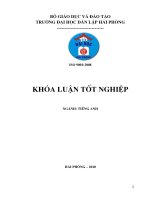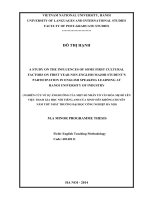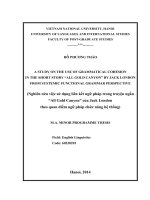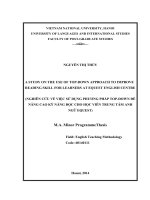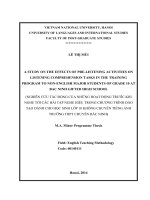A study on the flouting of maxims used in the novel “the sun also rises” by ernest hemingway
Bạn đang xem bản rút gọn của tài liệu. Xem và tải ngay bản đầy đủ của tài liệu tại đây (500.58 KB, 88 trang )
MINISTRY OF EDUCATION AND TRAINING
HANOI OPEN UNIVERSITY
M.A. THESIS
A STUDY ON THE FLOUTING OF MAXIMS
USED IN THE NOVEL “THE SUN ALSO RISES”
BY ERNEST HEMINGWAY
(NGHIÊN CỨU VỀ VI PHẠM CÁC PHƯƠNG CHÂM HỘI THOẠI TRONG
TIỂU THUYẾT “MẶT TRỜI VẪN MỌC” CỦA NHÀ VĂN ERNEST
HEMINGWAY)
NGUYỄN THANH HUYỀN
Field: English Language
Code: 60220201
Supervisor: DO KIM PHUONG. PhD
Hanoi, 2016
CERTIFICATE OF ORIGINALITY
I, the undersigned, hereby certify my authority of the study project report
entitled: “A study on the flouting of maxims used in the novel “The sun
also rises” by Ernest Hemingway” submitted in partial fulfillment of the
requirements for the degree of Master in English Language. Except where
the reference is indicated, no other person’s work has been used without due
acknowledgement in the text of the thesis.
Hanoi, 2016
Nguyen Thanh Huyen
Approved by
SUPERVISOR
DO KIM PHUONG. PhD
Date: October, 2016
i
ACKNOWLEDGEMENTS
This thesis could not have been completed without the help and support
from a number of people.
First and foremost, I would like to express my sincere gratitude to Do Kim
Phuong. PhD, my supervisor, who has patiently and constantly supported me
through the stages of the study, and whose stimulating ideas, expertise, and
suggestions have inspired me greatly through my growth as an academic
researcher.
A special word of thanks goes to all my lecturers at Hanoi Open University,
without whose support and encouragement it would never have been
possible for me to have this thesis accomplished.
Last but not least, I am greatly indebted to my family, my husband for the
sacrifice they have devoted to the fulfillment of this academic work.
Nguyen Thanh Huyen
ii
ABSTRACT
This study is made to analyze the flouting maxims used in the novel “The
sun also rises” by Ernest Hemingway. The research problems of the study
are the flouting of maxims. The study is further elaborated into: the flouting
of quality maxim, the flouting of quantity maxim, the flouting of relevance/
relation maxim, the flouting of manner maxim. The study is expected to be
beneficial to the world of literature. In addition, the author hopes the result
of the study will give additional information to the readers and can
contribute to the development of literary study particularly among students
who are interested in the literary study. It is a qualitative study focusing on
the flouting of maxims of the novel. Firstly, the data were gathered by
picking up the utterances within conversation which reveals the flouting of
maxims. Secondly, the author started to analyze the data in conducting the
analysis, the author used Grice’s classification which divides the maxims
into
four
categories,
namely
quality
maxim,
quantity
maxim,
relevance/relation maxim, and manner maxim. Finally, the author classified
the data into each category where they belong to and gave a little comment
on the case. As a result, the author found how the maxims were flouted and
then drew the inferences dealing with the case. From the results, it was
known that the flouting of maxims occur in all kinds of Grice’s maxims with
no exception, and it is done in various ways.
iii
LIST OF FIGURES
Figure 1. Frequency of occurrences of types of the flouting of
36
maxims
Figure 2. Percentages of types of the flouting of maxims
36
iv
TABLE OF CONTENTS
Contents
Certificate of originality
i
Acknowledgements
ii
Abstract
iii
List of figures
iv
Chapter 1: INTRODUCTION
1.1.
Rationale for the research
1
1.2.
Aims of the research
3
1.3.
Objectives of the research
4
1.4.
Scope of the research
4
1.5.
Significance of the research
4
1.6.
Structural organization of the research
6
Chapter 2: LITERATURE REVIEW
2.1. Conversation
7
2.2. Cooperative Principles
9
2.3. Conversational implicature
14
2.4. Flouting maxims
17
Chapter 3: METHODOLOGY
3.1.
Research-governing orientations
26
3.2.
Research methods
30
3.3.
Summary
34
Chapter 4: FINDINGS AND DISCUSSIONS
4.1.
Findings
35
4.2.
Discussions
58
Chapter 5: CONCLUSION
5.1.
Recapitulation
61
5.2.
Limitation of the research
63
5.3.
Suggestions for further research
63
REFERENCES
64
APPENDIXES
67
Chapter 1
INTRODUCTION
1.1. Rationale
Conversation is very important in communication. In daily communication,
various style of conversation occurs and is used for many purposes. It is
used for socializing, expressing feeling, sharing knowledge and ideas,
maintaining good relationships with others, and others related to human
interactions in life. Levinson (1983:284) defined conversation as the
familiar kind of talk in which two or more participants freely alternate in
speaking, which generally occur outside specific institutional settings like
religious services, law courts, classrooms, and the like. In understanding
the messages conveyed in the daily conversation, it is needed that we learn
and study about one of an idea in pragmatics which called conversational
implicature. Levinson (1983:101) described conversational implicatures as
“a non-conventional implicature based on an addressee’s assumption that
the speaker is following the conversational maxims or at least the
cooperative principle”.
In producing a good conversation, participants need to understand each
others’ meaning of the utterance. That is why the participants tend to
follow the cooperative principle and the conversational maxim by giving
enough, true, related, and arranged utterance which is assumed as explicit
information. On the other hand, conversational implicature tends to flout
the conversational maxim. Grice (1975) categorized the cooperative
principle of conversation and elaborates it in four sub-principles: (1)
maxim of quantity, (2) maxim of quality, (3) maxim of relation, and (4)
1
maxim of manner. Yule (1996: 37) says that it is important to recognize
these maxims as unstated assumptions we have in conversation. Efforts to
understand the meaning assumed from the flouted conversational maxim
in the conversation implicature has been doing by many participants of
conversation. When people have conversation, there is a risk that one
could misunderstand the others. Thus, Grice (1975), proposes a principle
called “Cooperative Principle” in conversation. This principle has to be
followed so that people could have a smooth conversation. To fulfill this
principle, Grice states four maxims to be followed. However, from some
investigations, the flouting of maxims could create humorous effects in
certain situation such as novels.
In a novel, many utterances have different meanings. Furthermore, as
novel’s lovers, we might to know what the conversational purpose is.
Conversation in the novel does not always follow Grice’s principle
including conversational maxims. In a conversation, utterances or
sentences that flouted maxims can be found. Understanding the meaning
of a conversation is needed by a viewer in order to avoid
misunderstanding. In Ernest Hemingway’s The sun also rises the
flouting maxims also happen. The sun also rises has many utterances or
sentences that flouted maxims. The case of flouting maxims in the novel
is represented by the data, which are classified into four categories. The
data collected show that the flouting of those maxims occurs in all kinds
of Grice’s maxims with no exception. The following example is taken in
“The Sun Also Rises” (Page 5)
Jake: Don’t you like Paris?
2
Georgette: No.
Jake: Why don’t you go somewhere else?
Georgette: Isn’t anywhere else.
Georgette flouts the maxim of quality by uttering thing, which is untrue,
namely that there is nowhere else but Paris. Of course, it is blatantly false
for in fact there are so many other places in the world besides Paris. Jake
must assume that Georgette is being cooperative. In order to preserve the
assumption of cooperation, Jake then, will have to infer a particular reason
(for example, she cannot go to other places) why she makes an apparently
untrue remark. The implicature in above is essentially that there is
something, which has been forcing her to stay in Paris. She has no choice
at all about where she can live in accordance with her wants. She has to
stay there no matter what. Although she is eager to move to any other
places, she cannot do it anyway.
This phenomenon is quite interesting to be explored. It is significant to the
development of science on Pragmatics since it can be used as a way of
solving problems appearing in dealing with the conversational maxims.
Considering those statements, in this study the author would like to
attempt to analyze such a phenomenon found in a literary work. Here I
carry out a research entitled “A study on the flouting of maxims used in
the novel “The sun also rises” by Ernest Hemingway.
1.2. Aims of the research
The aims of the study are to analyze the flouting of maxims used by the
characters taken in “The sun also rises” novel written by Ernest
Hemingway. Besides, this study also brings the answers from the research
3
problems of the study. In writing this thesis, the author would like to
solve the study problem concerning how the maxims are flouted.
1.3. Objectives of the research
Based on the above stated aims of the study, the objectives of this study are:
(i) To point out the conversational maxims that are flouted in the novel
“The sun also rises” by Ernest Hemingway.
(ii) To seek out the hidden meanings behind the flouting maxims used in
the novel “The sun also rises” by Ernest Hemingway.
1.4. Scope of the research
This study concerns with discourse analysis. The author only analyses the
characters’ conversation which contains the flouted maxims in Ernest
Hemingway’s “The sun also rise”. In analyzing, Grice’s theory of
conversational maxims is used as the basic theory to analyze the
conversations. In addition, I want to find out the reasons why the writer
used the flouting maxims for answering the research questions.
1.5. Significance of the research
This study is expected to give both practical and theoretical contributions in
relation to the study of cooperative principle.
(i)
Theoretical significance
4
The result of this study is based on the Cooperative Principle and
Conversational Implicature theory formulated by Grice. It will
strengthen Grice’s theory by performing how the assumption of
conversational maxims goes on in the conversation and how the maxims
are flouted by the speakers to imply what they intentionally mean. This
also gives more explanation about the flouting maxims used in the novel
“The sun also rises” by Ernest Hemingway generated from the
conversations. It helps the description of language aspect that can be
discussed through linguistic study, which focuses on the speaker’s
intended meaning constructed from their utterances to gain better
understanding of communication in daily life.
(ii)
Practical significance
This study is expected to be useful for Vietnamese learners of English,
especially the trainee translators to broaden their understanding about
Grice’s theory concerning conversational maxims and flouting of
maxims that generates implicatures or hidden meanings. They will get
new insight what conversational maxims are flouted in the novel “The
sun also rises” by Ernest Hemingway and the implicatures conveyed
behind the characters’ utterances. The trainee translators will also learn
how to generate implicature effectively in their communication without
irritating the addressee to convey what they really mean in their
utterances. Moreover, this study provides Vietnamese learners of
English with the inspirations as their further study in this field.
5
1.6. Structural organization of the study
The study is organized into 5 chapters as follows:
Chapter I, Introduction presents the rationale, the aims and objectives of
the study, the scope of the study, the research questions, the significance
of the study and the organization of the study.
Chapter II, Literature review provides the previous studies related to the
paper, and some theoretical backgrounds of the study discussing the
theories used as the bases of the study.
Chapter III, Methodology focuses on presenting research questions,
research setting, research approaches, data collection, as well as methods
of analysis.
Chapter IV, Analysis and Discussion presents analysis and discussion of
the study findings. The chapter concerns with the interpreting and
drawing inferences of the findings.
Chapter V, Conclusion summaries the major findings recorded during
the making of the thesis. The chapter presents the limitations of the
study and provides some suggestions for further research as well.
6
Chapter 2
LITERATURE REVIEW
In order to make a better understanding about the study, the author used a
particular
theory from an expert to come into the analysis and the
conclusion. Grice’s theory of cooperative principle (1975) has been used
as the basic of the analysis. The author collected some theories about the
notion of conversation, cooperative principle, conversational implicatures,
and the flouting maxims. This review is very important as it is used as the
basic of the analysis of the study.
2.1. Conversation
Living in a society, one always gets along with so many other people around
him. They, in getting along, need to communicate and to interact with each
other. One of the ways they have to exchange their ideas is having
conversation. Therefore, no wonder if human beings spend a large part of their
lives engaging in conversation. They cannot be separated from making
conversation in their daily activities. It cannot be denied that in their life,
conversation takes a more dominant role than any other way of communication
like writing letters, interviews, or speeches, for examples.
Conversation itself is one of the forms of oral communication event in which
there should be a speaker and at least a listener who are doing talk exchanges. It
may occur between at least two individual. According to Cook (1989:51), the
number of participants in conversation is small; talk is primarily for the
7
participants not for an outside audience; and speaking turns are quite short. So,
conversation can be clearly described as an activity where, for the most part,
two or more people who intend to do social interaction take turns at speaking.
Typically, only one person speaks at a time. It means that when one person
speaks, another/the others listens/listen.
Conversation is an activity that is governed by a certain set of conversational
rules. As a result, conversation is not a random activity, but it is an activity that
shows orderliness. It is not a random succession of unrelated utterances
produced alternately by participants. On the other hand, it has something in the
nature of a general purpose or direction, and the contributions of the
participants are intelligibly related both to one another and to the overall aim of
the conversation. Hence it is not an activity that does not have a goal. This
communication activity always lasts within a condition bound to goal/mutual
end that will be reached by conversationalists. When people take part in
conversation, they bring to the conversational process shared assumptions and
expectations about what conversation is, how conversation develops, and the
sort of contribution they are each expected to make. From this, we finally arrive
at the conclusion that the goal of conversation is the understanding between
speaker and listener about the message the speaker is trying to convey.
In connection with achievement of the goal/mutual end in conversation, an
unstated assumption underlies conversation. The assumption is that, when
engaged in conversation, people intend to behave cooperative; they implicitly
signal that they agree to cooperate in the joint activity. It means that in
conducting conversation they share knowledge and expectation about what
8
conversation is; they share belief that they normally do not try to confuse, trick,
or withhold relevant information from each other and that the speaker will not
intend to mislead the listener. The speaker, then, thinks and expects the listener
to think what the speaker is thinking, that the listener is able to get the meaning
he/she tries to convey. Without this underlying assumption, conversation will
not be considered worth carrying out for the communicative process will break
down to the detriment of everyone. “Successful communication, or the
successful transfer of meanings, is thus seen as a process by which a state of
mutual knowledge of a communicative intention is attained, with help of
(intentionally applied) principles of conversation” (Verschueren, 1993:47). The
cooperative principle therefore will take an important role in talk exchanges.
Grice who argued about this assumption formalized it into what he called the
cooperative principle.
2.2.
Cooperative Principles
The cooperative principle, which is mutually understood between interlocutors,
is a basic assumption to govern purposeful and effective communication in
conversation. Grice, as quoted by Schiffrin (1994:194), proposes the
cooperative principles as a general principle that participants will be
expected to observe says “make your conversational contribution such as is
required, at the stage at which it occurs, by the accepted purpose or direction
of the talk exchange in which you are engaged”. Or, to locate it in other
words: act in conversation according to the general principal that you are
mutually engaged with your listener in an activity which is of benefit to both of
you. People engaged in conversation will say something suitable at stage at
9
which the conversation occurs. Grice has made this cooperative principle
somewhat more explicitly by elaborating it into a set of conversational rule
called maxims of conversation. The function of these maxims is as guidelines
about how participant in conversations should behave in conducting
conversation. So, these maxims illustrate behavior participants carry to
conversation; regulate what they say so that it contributes to accepted direction
or mutual end of conversation. The details of these maxims are as follows:
2.2.1. Quality Maxim
Under the category of quality, this maxim refers to the importance of making
only statements one believes to be true as Grice (1975) expects that the
contributions to “be genuine and not spurious.” In short, the speaker is
expected to be sincere and tell the truth. They are assumed not say anything
that they believe to be false or anything for which they lack evidence. The
reason is that if he/she gets making false statements he/she will lose one of
the most important social assets a person can have, credibility.
In other words, each participant’s contribution should be truthful and based
on sufficient evidence (Parker, 1994: 23). It simply means that the speaker
says only what they believe to be true and that for which they have sufficient
evidence. Here, obviously there will not be adequate evidence for a false
statement. This quality maxim can be paraphrase as “Do not make
unsupported statements”. If not, it would be extremely difficult to maintain
conversation with our partner. Example:
Niken : London is the capital of French, isn’t it?
John : No, you’re wrong.
10
As a matter of fact, the capital of French is Paris, not London. Thus, John’s
answer in clearly conforms to uality maxim because Niken’s statement is
wrong. It will be different if he says, “Yeah, and Tokyo is the capital of
Canada”, for instance. Such an answer will completely not conform to
quality maxim since he says something, which is totally untrue. The capital
of Canada is not Tokyo but Ottawa, while Tokyo is the capital of Japan.
2.2.2. Quantity Maxim
The category of quantity relates to the quantity of information to be
provided. Under this category requires one to “be as informative as
required.” This maxim means that the speaker has to include all the
information that the hearer requires to understand. If the speaker leaves out a
crucial piece of information, the hearer will not understand what the
speaker is trying to say. On the other hand, providing too much information
during course of a conversation can be perceived as
superfluous
and
insignificant to the other person. According to the second maxim, which
requires one to “be brief”, the speaker should avoid unnecessary or
redundant information in his contribution.
According to this maxim, each participant in conversation has to provide
enough information; it should not be less informative or more informative.
For example:
Anita : Where are you going?
Nathan: I’m going downtown.
In the example, sufficient information is given by Nathan, without
redundancy. His remark is appropriate to quantity maxim. The case will be
11
different if his remark is, for instance “I’m going downtown to go window
shopping”. Such a remark is not appropriate to quantity maxim although it is
still a sufficient contribution. It is because it gives more information than is
required – Anita does not ask him about what he is going downtown for.
2.2.3. Relation/Relevance Maxim
Under the category of relation, Grice (1975) places a single super maxim
namely “be relevant”. The demand for relevance simply means that the
speaker should
only include information in the communication that is
relevant to the topic being discussed.
“The maxim states that each participant’s contribution should be relevant to
the subject of the conversation” (Parker, 1994:23). In other words, people’s
contribution engaged in conversation should be relevant to the subject of the
conversation itself. Example:
Adit : Have you finished your thesis?
Atik : Yes, I have.
In the example, it is obvious that the only related contribution to Adit’s
question is “yes/no” answer. Atik thereby has said something she should do.
So, just like the first two examples, this one also conforms to the maxim.
She will make her remark inappropriate to relevance maxim if she, for
instance says thing like “Is the Pope Moslem?” The reason is that such a
remark doesn’t have any connection with Adit’s question.
2.2.4. Manner Maxim
12
The maxim of manner obligates speaker’s utterance to be perspicuous which
is not to be ambiguous, obscure, or disorderly and unnecessary prolixity.
Therefore, each participant’s contribution should be reasonably direct, that
is, it should not be vague, ambiguous or excessive wordy.
In other words, each participant’s contribution should be reasonably direct;
that is, it should not be vague, ambiguous, or excessively wordy (Parker,
1994:23). Meanwhile, Cruse (2000: 357) points out that the maxim of
manner cautions the speaker to be methodical and to avoid ambiguity,
prolixity, and obscurity. The first rule of manner maxim enjoins us to avoid
use of jargon or other terms our listener cannot be expected to know. The
second one requires us to avoid saying things that have two or more
meanings unless our listeners can be expected to know which meaning is
deliberate. The third one wants us to avoid unnecessary prolixity. As Cruse
(2000:357) said that not everybody knows what prolixity means, and the
Concise Oxford Dictionary says it means “lengthy, tediously wordy”. So, it
tells us not to expound at length on a topic when a few words will do. The
fourth one comes down to saying that we should organize what we say in
some intelligible way. The orderliness Grice had in mind, as cited by Cruse
(2000:357) was recounting events in the order that they occurred. Example:
Irphan : What should we have for the kids?
Een : Anything but ice cream.
In the example, Een provides a normal contribution in replying to Irphan’s
question. There is no ambiguity or obscurity in her utterance. She also
replies in a brief utterance. It is thereby appropriate to manner maxim. Just
compare with if she, for instance says “Anything but I-C-E C-R-E-AM-S”.
In this utterance she spells out the word ice cream that would only make her
13
not to be perspicuous as manner maxim enjoins us to do. Her answer will be
considered to be inappropriate to manner maxim.
Grice emphasized that it is important to recognise these maxims as unstated
assumptions we have in conversation. Yule (1996:37) assumed that people
are normally going to provide an appropriate amount of information; we
assume that they are telling the truth, being relevant, and trying to be as clear
as they can. Because these principles are assumed in normal interaction,
speakers rarely mention them.
After taking a look at Grice’s maxims closely, we can conclude that
conversational maxims actually describe rational means for conducting
cooperative talk
exchanges in conversation. In short, as Levinson
(1983:102) stated in supporting the above idea, these maxims specify what
participants have to do in order to converse in a maximally efficient,
rational, cooperative way: they should speak sincerely, relevantly and
clearly, while providing sufficient information. However, in fact, speakers
often flout Grice’s maxims rather than always adhering to them. Whenever
any of the maxims is flouted, there must be an extra meaning that speakers
try to convey beyond what is literally expressed. As a result of this flouting
of maxims, conversational implicature, which plays an important part in
communication arises.
2.3. Conversational implicature
Conversational implicature which was firstly introduced by the philosopher
Herbert P. Grice is one of the studies of Pragmatics. It is a pragmatics
implication, a kind of implicative proposition or statement that what is possibly
14
meant, implied, or intended by the speaker is different from what is actually
said in a conversation. So, it tends to deal with the speaker‘s meaning rather
than the linguistic meaning of an utterance. A conversational implicature, as
Mey (1994:103) puts it, is something which is implied in conversation, that is,
something which is left implicit in actual language use. Meanwhile, Implicature
is generated intentionally by the speaker and may (or may not) be understood
by the hearer (Thomas, 1995:58). Consider the examples below:
The situation: Arya come from school and starts his destructive journey
through the biscuit barrel, and his mother asks him.
Mother : Why didn’t you eat your school lunch?
Arya : It’s the taste.
Arya’s mother must understand what her son actually implies in his words to
find out the real meaning of his utterance. It is because what he says is more
than it appears to mean. The implicit meaning (extra meaning) she may infer is
that the taste of the food is not good.
Yayi’ : When’s Devi’s birthday?
Fery : It’s sometime in June.
As we all know, someone’s birthday always include both the date and the
month on which he/she was born. However, Fery in the example doesn’t give a
normal answer. He does not mention the date of Devi’s birthday. He has
something implied in his utterance that his interlocutor must find. “Sometime in
June” will tell her that the only thing the speaker remembers about Devi’s
birthday is the month in which it occurs. The extra meaning she may infer is
that he does not know whether Devi’s birthday is at the beginning, the middle,
or the end of that month. He does not know the date of Devi’s birthday.
15
Grundy (2000:71) also gave example: One Saturday morning, he went in when
the post office had just opened.
Post master: It’s a nice morning, isn’t it?
Peter: Not bad.
Post master: It will be better at one o’clock
Grundy understood him to mean that he would be happier when the post office
had closed, but again, he never explicitly stated this. For the present, it is
sufficient to notice that the context is very important in determining what
someone means by what they say. Knowing that the post office closes at one
o’clock on a Saturday enables us to understand what is meant by saying “it will
be better at one o’clock”. And because its part of their culture to believe that
people find it hard to think properly early in the morning.
The example above shows us how important context is in helping us to
understand utterances. In the case of implicature, context helps us to determine
what is conveyed implicitly but not explicitly stated by the speaker.
After examining the examples closely, we now know what is meant by
conversational implicature exactly. It is precisely the extra meaning (additional
conveyed message) we infer from the speaker’s utterance when he means more
than he says. Such messages are part of what is communicated indeed, but they
are not part of the meaning of the word in the utterance since they are not said.
They are conveyed indirect and understood implicitly without ever being
explicitly stated.
It is sufficient to notice that the context is very important in determining what
someone means by what they say. Given different context, we would have
understood that the same utterances will have different meaning.
16
Kempson, as cited by Fasold (1990), points out several characteristics of the
cooperative principle and conversational implicature, among others are:
(1) Conversational implicatures depend on everyone concerned recognizing the
cooperative principle and its maxims
(2) The implicatures will not be part of the meaning of the words in the
sentence
(3) Working out an implicature depends on assumptions shared by the
participants in a particular speech event.
Conversational implicature becomes very important in the flouting maxims for
it arises as a result of what happened to the flouting of those maxims.
2.4. Flouting maxims
According to Grice’s theory, interlocutors operate on the assumption that as
a rule, the maxims will be observed. But when speakers appear not follow
the maxims but expect hearers to appreciate the meaning implied. Grice was
well aware, however, that there are many occasions when people fail to
observe the maxims. Grice (1975:49) stated that a speaker may flout a
maxim when s/he blatantly fail to fulfil it, not with any intention of
deceiving or misleading, but because the speaker wishes to prompt the
addressee to look for a meaning which is different from, or in addition to,
the expressed meaning. He called this additional meaning as “conversational
implicature.”
Thomas (1995:64) stated that a flout occurs when a speaker blatantly fails to
observe a maxim at the level of what is said, with the deliberate intention of
17

